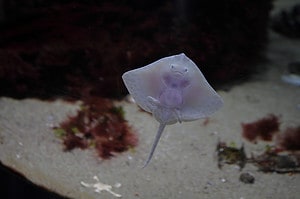One is cartilaginous while the other is gelatinous. They are unlikely to encounter one another and even less likely to attack if they do. But if ever there were a deep sea fight between a stingray vs. box jellyfish, which sea creature would win? Let’s find out!
Comparing a Stingray and a Box Jellyfish
| Stingray | Box Jellyfish | |
|---|---|---|
| Size | 4.6 to 8.2 feet wide on average | Up to eight inches along its sides and 12 inches in diameter |
| Speed and Movement | Up to 30 miles per hour | Up to 4.6 miles per hour |
| Defenses | Sharp tails they whip forward like a scorpion | Stinging tentacles contain venom |
| Offensive Capabilities | Strikes prey with its tail; chomps through prey with teeth | Stinging with nematocysts via touch; swallowing after incapacitating prey |
| Predatory Behavior | Use of their fins to envelope their prey; camouflaging in the sand | Use of tentacles to lure prey, and trapping them once close |
What Are the Key Differences Between a Stingray and a Box Jellyfish?
Though stingrays and box jellyfish share a marine environment, they are completely different sea animals. While stingrays have cartilaginous, flat bodies, box jellyfish have gelatinous bell-shaped bodies with long tentacles.

Stingrays range in size, sometimes measuring over eight feet wide.
©Vicki L. Miller/Shutterstock.com
What Are the Key Factors in a Fight Between a Stingray and a Box Jellyfish?
There are several factors to consider when it comes to a fight between a stingray and a box jellyfish. Size always plays a role, as it often provides the larger sea creature with an advantage. However, speed and movement can aid in a fight as well as powerful defenses and intentional offensive capabilities. How each hunt can also play a role in how they would respond when intending to incapacitate the other.
Stingray vs. Box Jellyfish: Size
Stingrays grow to different sizes but they’re typically bigger than box jellyfish. Although they can be a couple of inches, they can also grow to several feet in diameter, depending on the type of stingray. The box jellyfish is significantly smaller compared to a stingray. These jellyfish are only a few inches in size but can get up to a foot long. Some box jellyfish have longer tentacles than others.
Stingray vs. Box Jellyfish: Speed and Movement
The movement of stingrays is almost birdlike. They use their pectoral fins and move them up and down in an undulating motion, which allows them to travel through water. They can move quickly and they don’t do so in a frenzied state. As they move, they glide, appearing graceful as they travel. Box jellyfish have a completely different way of swimming. They have bell-shaped bodies that they contract and then expand to keep them moving. While stingrays have a smoother movement in the water, box jellyfish kind of pulsate to travel in the water.

Box jellyfish are small but mighty!
©Nuttawut Uttamaharad/Shutterstock.com
Stingray vs. Box Jellyfish: Defenses
Stingrays and box jellyfish are similar in that they both produce venom. However, in stingrays, it’s localized on their barbed tail, which they use to sting when they feel threatened. They whip their tail over kind of like a scorpion and inject venom into a predator. Box jellyfish, on the other hand, have multiple points where they can inject venom throughout their tentacles. The cells are called nematocysts. Once they make contact, they release their venom, which allows them to protect themselves when predators come too close.
Stingray vs. Box Jellyfish: Offensive Capabilities
Stingrays are known for having a docile temperament. They are not typically offensive and when they display their ability to envenomate, it’s usually because they’re feeling threatened somehow. They do, however, hunt, using their tail to strike their prey and then chomp through it with their teeth. Box jellyfish also use their tentacles when they are searching for prey. They have a strong venom that can incapacitate small fish and invertebrates.

Box jellyfish have multiple points where they can inject venom throughout their tentacles.
©IMC11/Shutterstock.com
Stingray vs. Box Jellyfish: Predatory Behavior
Stingrays cleverly conceal themselves within the sand, patiently waiting for prey to approach. They snack on small fish just like box jellyfish, but they also go for mollusks and crustaceans. When they see prey, they strike with their barbed tail and also use their fins to envelop their prey, effectively trapping it. Box jellyfish snack on invertebrates, plankton, and small fish. They use their tentacles to lure their prey and once they’re close, they envelop them, delivering their potent venom.

Stingrays use their pectoral fins, moving them up and down in an undulating motion, to travel through water.
©BlackFarm/Shutterstock.com
In a Fight Between a Stingray and Box Jellyfish, Who Would Win?
If it came down to a fight between a stingray and a box jellyfish, a stingray would win. The stingray has the advantage of its size, speed, and movement, which would allow it to evade the box jellyfish’s tentacles. Positioned just right, the stingray would use its barbed stinger, attacking the box jellyfish with precision.
Thank you for reading! Have some feedback for us? Contact the AZ Animals editorial team.








